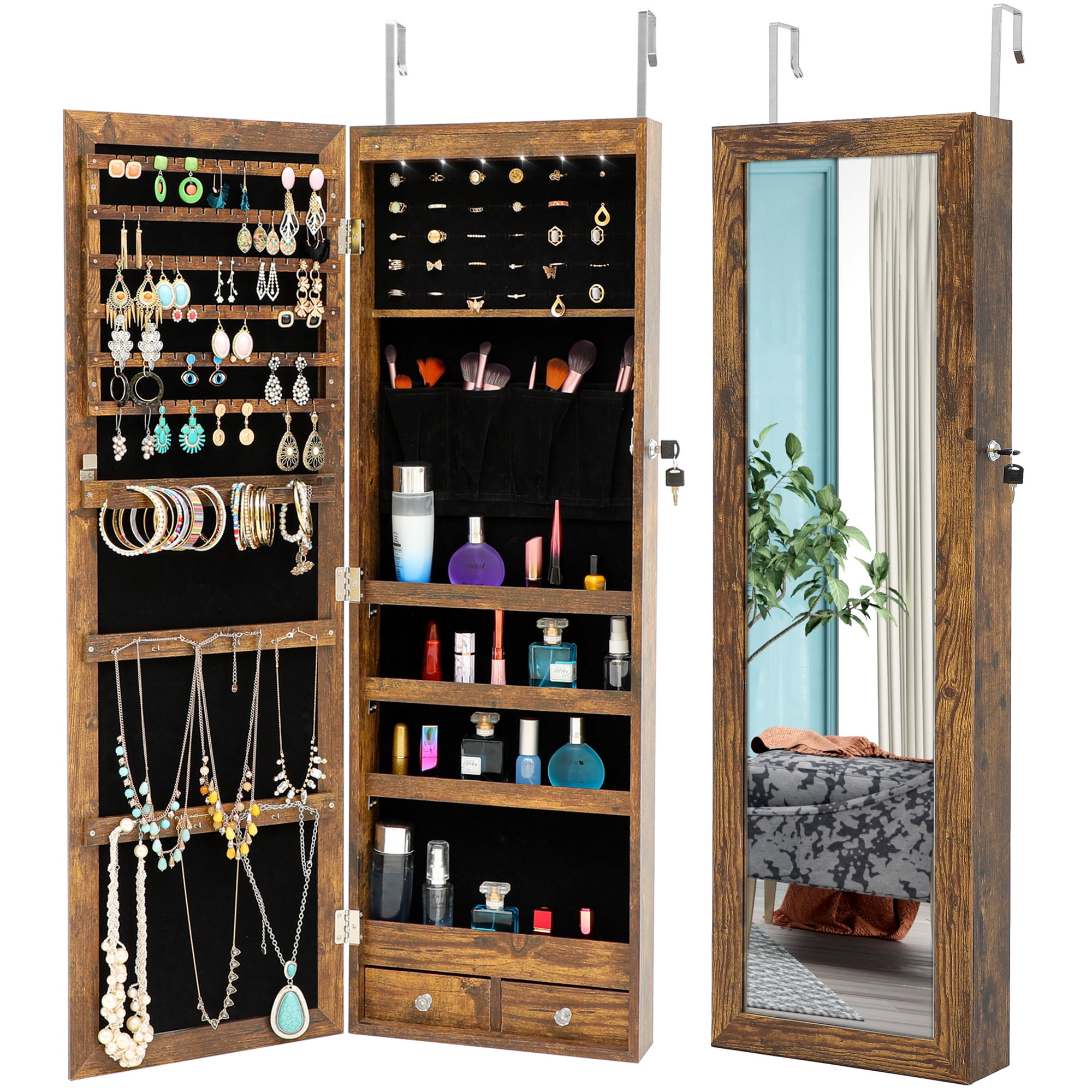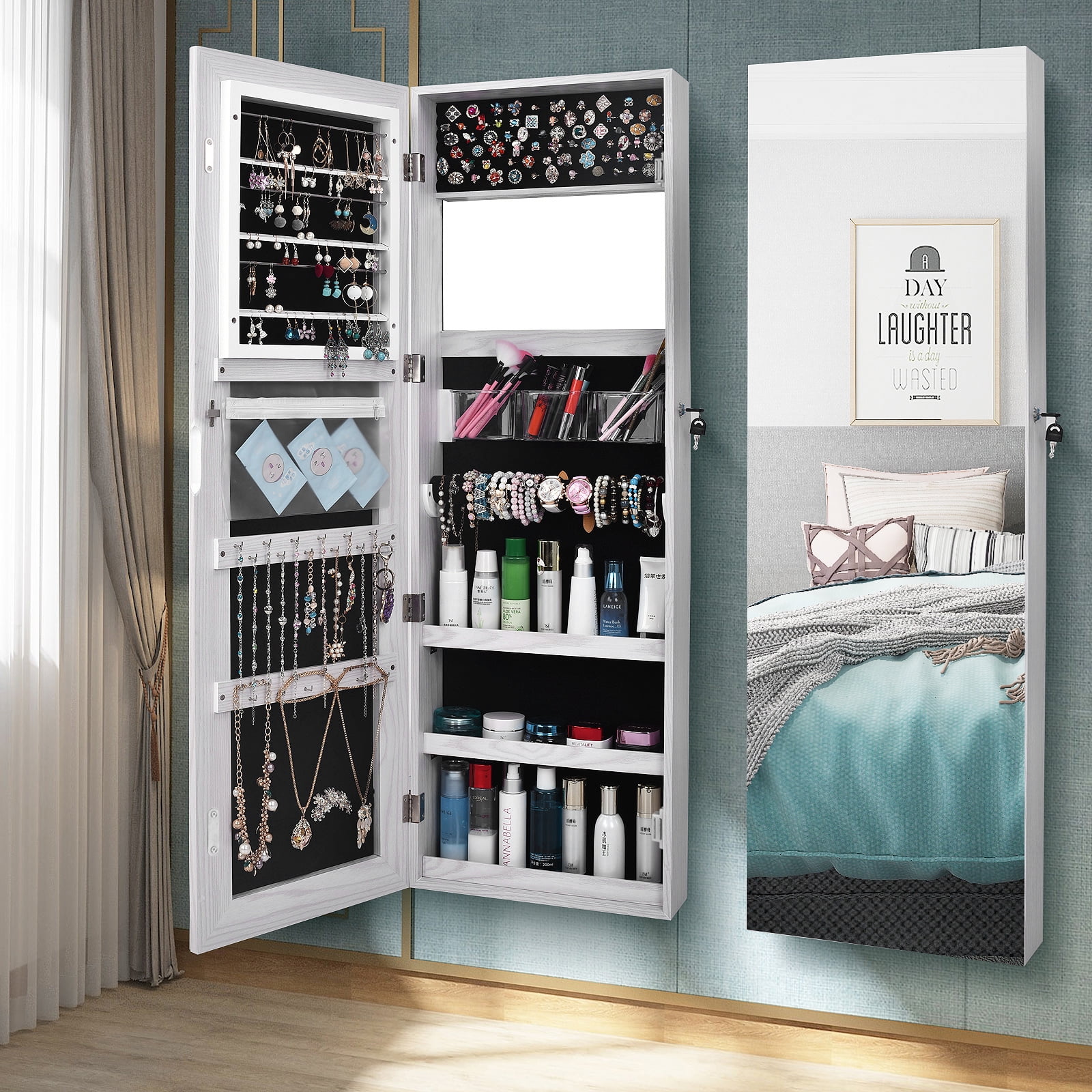Product Overview and Features: Over The Door Mirror Jewelry Cabinet

Over-the-door mirror jewelry cabinets offer a practical and stylish solution for organizing jewelry and accessories while simultaneously providing a full-length mirror. These versatile pieces blend functionality with aesthetic appeal, making them a valuable addition to any bedroom or dressing area. A wide range of designs and features cater to diverse tastes and storage needs.
Design and Style Variations, Over the door mirror jewelry cabinet
Over-the-door jewelry cabinets are available in a variety of styles and materials to complement different décor. Common materials include wood, metal, and plastic, each offering unique aesthetic qualities and durability levels. Wood cabinets often exude a classic and elegant feel, while metal options provide a modern and sleek look. Plastic cabinets are generally more affordable and lightweight, but may lack the durability of wood or metal. Mirror sizes vary, with some offering a full-length reflection while others provide a smaller viewing area. The quality of the mirror is also a crucial factor, with higher-quality mirrors offering clearer and less distorted reflections. Storage capacity varies greatly depending on the model’s size and design, ranging from compact cabinets suitable for minimal jewelry collections to larger pieces capable of holding extensive amounts of accessories.
Functionality and Features Comparison
Different models of over-the-door jewelry cabinets offer varying levels of functionality and features. Full-length mirrors are a common feature, providing convenient access to a full body reflection. Storage compartments vary significantly, with some models including drawers, shelves, and hooks to accommodate different types of jewelry and accessories. Drawers provide secure storage for delicate items, while shelves and hooks are ideal for necklaces, bracelets, and earrings. Locking mechanisms are available in some models, providing added security for valuable jewelry. The organization system within the cabinet also impacts functionality; some models offer customizable compartments or dividers to optimize space and organization. The ease of installation and door-hanging mechanism is also a key functional aspect to consider, with some models offering more secure and user-friendly systems than others.
Comparison of Popular Models
The following table compares four popular models of over-the-door mirror jewelry cabinets, highlighting key features, price range, and customer ratings. Note that prices and ratings can fluctuate based on retailer and time of purchase.
| Model | Key Features | Price Range | Customer Rating (Average) |
|---|---|---|---|
| Model A (Example: “Classic Oak”) | Full-length mirror, wooden construction, multiple drawers and shelves, key lock | $50 – $75 | 4.5 stars |
| Model B (Example: “Modern Metal”) | Full-length mirror, metal frame, various hooks and compartments, no lock | $30 – $50 | 4.0 stars |
| Model C (Example: “Compact Plastic”) | Smaller mirror, plastic construction, several shelves, no lock | $20 – $35 | 3.8 stars |
| Model D (Example: “Deluxe Organizer”) | Full-length mirror, wood and metal combination, numerous drawers, shelves, and hooks, key lock | $75 – $100 | 4.7 stars |
Installation and Use

Installing your over-the-door mirror jewelry cabinet is a straightforward process, designed for ease and convenience, even for those unfamiliar with such tasks. Remember to always prioritize safety and carefully read the included instructions before beginning. The process is largely the same regardless of door type, but minor adjustments may be necessary depending on door thickness and material.
Over the door mirror jewelry cabinet – The installation process typically involves attaching the cabinet to your door using either hooks or adhesive strips, depending on the model. For hook-style installations, carefully align the hooks with the top of your door and firmly press them into place. Ensure the hooks are securely fastened to prevent the cabinet from falling. For adhesive strip installations, clean the door surface thoroughly before applying the strips, ensuring a firm and even adhesion. Allow the adhesive to set according to the manufacturer’s instructions before loading the cabinet with jewelry.
Installation Steps for Different Door Types
While the basic installation remains consistent, slight variations may be needed for different door types and thicknesses. Solid core doors generally provide a more stable surface for hanging, while hollow core doors may require extra care to ensure secure attachment. Similarly, thicker doors may necessitate adjustments to hook placement or adhesive strip application.
- Assess Your Door: Determine your door’s material (solid core, hollow core, etc.) and thickness. This will inform your choice of installation method and any necessary adjustments.
- Choose Your Method: Select the appropriate installation method based on your cabinet’s design and your door’s characteristics. If using hooks, ensure they are appropriately sized and sturdy. If using adhesive strips, ensure they are rated for the weight of the filled cabinet and the material of your door.
- Prepare the Surface: Clean the area on your door where the cabinet will be installed. Remove any dust, dirt, or debris to ensure proper adhesion (for adhesive methods) or secure hook placement.
- Attach the Cabinet: Carefully align the hooks or adhesive strips with the top of your door and firmly attach the cabinet. Follow the manufacturer’s instructions precisely. For adhesive strips, allow sufficient drying time before loading the cabinet.
- Test for Stability: Gently test the cabinet’s stability after installation. If it feels unsteady, re-evaluate the installation and make necessary adjustments.
Organizing Jewelry Effectively
Efficient organization is key to maximizing your jewelry cabinet’s storage capacity and ensuring easy access to your favorite pieces. Categorizing your jewelry by type and then further sub-categorizing by material, color, or style will help maintain order and make finding specific items much simpler.
- Necklaces: Consider using necklace organizers with slots or hooks to prevent tangling. Categorize by length, style (e.g., delicate, statement), or occasion.
- Earrings: Use earring organizers with compartments or small trays to keep pairs together and prevent loss. Categorize by type (studs, hoops, drop earrings), metal, or color.
- Bracelets: Arrange bracelets neatly on bracelet bars or in designated compartments to avoid scratching. Categorize by material (e.g., metal, leather, beads), style, or color.
- Rings: Utilize ring rolls or small trays to keep rings separated and organized. Categorize by size, metal, style, or stone.
Visual Guide to Jewelry Arrangement
Imagine a cabinet with several shelves. The top shelf could feature a mirrored section for easy viewing, followed by a section with several hooks for necklaces organized by length, starting with the longest at the back and shortest at the front. The next shelf could contain small compartments for earrings, organized by type (studs, hoops, dangles) with each compartment clearly labeled. The third shelf could showcase a bracelet bar across the back, with smaller compartments at the front for stacking bracelets categorized by material. Finally, the bottom shelf could hold several ring rolls, each dedicated to a different ring style or metal type.
Benefits and Considerations
Choosing the right jewelry storage solution can significantly impact how easily you access your cherished pieces and how well they are protected. An over-the-door mirror jewelry cabinet offers a unique blend of accessibility and style, but it’s crucial to weigh its advantages and limitations before making a purchase. This section explores the benefits of this type of storage compared to alternatives and highlights potential drawbacks to help you make an informed decision.
The convenience of an over-the-door mirror jewelry cabinet is undeniable. Unlike rummaging through jewelry boxes or drawers, this cabinet provides a clear, organized view of your collection. The mirrored surface also offers a practical advantage for applying makeup or checking your appearance, maximizing space and functionality. Compared to storing jewelry in a dresser drawer, where pieces can become tangled or scratched, the cabinet’s compartments offer dedicated spaces for necklaces, earrings, and bracelets, minimizing the risk of damage.
Space Optimization and Accessibility
This type of storage excels in maximizing limited spaces. Apartments or smaller bedrooms often lack ample dresser space, making an over-the-door cabinet a perfect solution. Its vertical design utilizes otherwise wasted door space, effectively transforming a typically unused area into a functional storage unit. The mirrored front allows for easy viewing of all your jewelry, eliminating the frustration of searching through cluttered boxes or drawers. This immediate visual access significantly streamlines your morning routine, allowing for quicker selection of jewelry pieces.
Limitations and Compatibility
While offering many benefits, potential drawbacks should be considered. The cabinet’s dimensions are crucial; ensure it’s compatible with the thickness of your door. A cabinet designed for a standard door might not fit a thicker, solid-core door. The cabinet’s weight capacity is another important factor. Overloading it could cause the door to sag or even damage the cabinet itself. The durability of the materials used in construction also varies, impacting the longevity of the product. Some cabinets are made of sturdy materials that can withstand daily use, while others might be less robust and prone to damage. Consider reading reviews to gauge the quality and longevity of a particular model before purchasing.
Durability and Material Considerations
The material used in the construction of the cabinet significantly impacts its durability and lifespan. Some cabinets are crafted from high-quality wood or sturdy plastic, offering excellent resilience against wear and tear. These durable options are less prone to scratches, dents, and warping over time, ensuring your jewelry remains well-protected. However, less durable materials, such as thin plastics or cheaply made wood, might be susceptible to damage from frequent use or accidental impacts. Therefore, investing in a cabinet constructed from robust and high-quality materials is a wise decision to ensure the longevity of the product and the protection of your jewelry collection.
